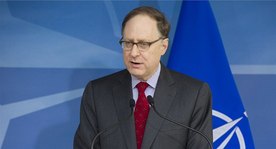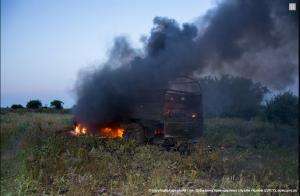
NATO Deputy Secretary General Ambassador Alexander Vershbow discussed NATO’s new partnership policies in Poland on Friday
NATO has promised that the transatlantic security partnership must focus not only on collective defense in its immediate region, but global partners as well, in a “post-Crimean world”.
The statement came from NATO Deputy Secretary General Ambassador Alexander Vershblow on Friday at Wrocław Global Forum in Poland.
“Our Strategic Concept sets out collective defense, crisis management, and cooperative security as three essential core tasks for NATO,” Mr. Vershblow said. “Although Russia’s aggression against Ukraine has changed the strategic environment in a fundamental way, all three core tasks remain essential, valid and vital for our security.”
Mr. Vershblow went on to accuse Russia of changing borders “through force”, continuing to subvert a sovereign state [Ukraine] through covert means and a cynical disinformation campaign,” ripping “up the international rule book”, and seeking to “recreate a sphere of influence based on a dangerous new doctrine of limited sovereignty for countries that form part of the so-called ‘Russian World’.”
Following Moscow’s annexation of Crimea in March, NATO has heavily criticized and rebuked Russia’s “aggressive” actions in Ukraine, which the Alliance believes are bent on expanding the Kremlin’s power.
Since the Ukraine-crisis began, NATO has taken steps to meet the crisis and strengthen collective defense from the Baltic to the Black Sea, Mr. Vershblow said.
Every NATO member is contributing in one way or another; either with aircraft, naval ships, ground troops and/or commanders and planners, he added.
NATO is also “considering the longer-term implications of Russia’s actions for our Alliance.”
Over the last few months, Western countries have applied sanctions against Russia–allegedly damaging its already crippled economy–in consequence for Moscow’s supposed backing of anti-Kiev separatists in Eastern and Southern Ukraine.
In light of the conflict between the EU and the US and Russia over Ukraine, NATO Defense Ministers discussed earlier this week about a “Readiness Action Plan”, which includes improving NATO’s reaction time, enhancing its intelligence and awareness capabilities, pre-positioning equipment and supplies further East, “and carrying out more high-intensity military exercises in more demanding scenarios.”
NATO is also working towards filling “capability gaps” that exist within the alliance, Mr. Vershblow said. These gaps include drones, transport aircraft, Special Forces and deployable C2, all of which are needed to be able to “react quickly, together, and effectively to all threats, whether here in Europe or out of area.”
Ambassador Vershblow stated that developing these capabilities “puts a premium on our ‘Smart Defense’ multinational capability projects, and on further regional cooperation.” He added that “Poland and its Višegrad partners continue to demonstrate that this is a pragmatic and cost-effective way to build greater security together, and in a way that makes both NATO and the European Union stronger.”
Mr. Vershblow challenged NATO members who do not spend the required 2% of their GDP on defense, to raise their defense spending to the expected percent.
Order Descending NATO Members’ GDP Defense Spending According to WorldBank
- U.S. 4.2%
- Greece 2.6%
- U.K. 2.4%
- France 2.3%
- Turkey 2.3%
- Estonia 1.9%
- Poland 1.9%
- Portugal 1.8%
- Croatia 1.7%
- Italy 1.7%
- Albania 1.5%
- Bulgaria 1.5%
- Denmark 1.4%
- Norway 1.4%
- Canada 1.3%
- Germany 1.3%
- Netherlands 1.3%
- Romania 1.3%
- Slovenia 1.2%
- Belgium 1.1%
- Czech Republic 1.1%
- Slovakia 1.1%
- Lithuania 1.0%
- Latvia 0.9%
- Spain 0.9%
- Hungary 0.8%
- Luxembourg 0.6%
- Iceland 0.1%
“The crisis in Ukraine has made us go ‘back to basics’ and focus more on collective defense,” Mr. Vershblow said. But it must not “lead to a self-centered, inward-locking Alliance,” he added. The Alliance must focus on the “Future NATO” that is needed to meet the “evolving 21st century security needs.”
Dialogue and cooperation with partner countries is “vital” to fulfill NATO’s vision of the future, the ambassador said. This applies to NATO members, and Ukraine and “other Eastern neighbors whose sovereignty is being challenged by Russia.”
Mr. Vershblow stated that partnership is crucial for keeping Europe free, stable, and peaceful, and NATO must keep its doors open for European partners who wish to join the Alliance.
He also added that NATO, in coordination with the EU, the UN, and regional organizations such as the African Union, must do what they can to help countries in the Middle East and North Africa develop their own defense capacity.
In conclusion to his speech, Mr. Vershblow summarized NATO’s new policies: “when it comes to shaping transatlantic security and defense in a post-Crimean world, we should avoid false choices. NATO’s duty is to defend all 28 Allies against any possible risk or threat to their security, whenever and wherever it may occur. This means we not only need the right capabilities, but also the right connections, so that we can deter aggression at home and project stability abroad.”
A Plan to Bring Peace to Ukraine
While responding to journalists on Friday at the 70th Anniversary of D-Day in Northern France, Russian President Vladimir Putin said that the newly-elected Ukrainian President Petro Poroshenko had mentioned to him a “plan” to bring an immediate cease-fire between Ukraine military forces and separatists in Ukraine.
In recent weeks, Moscow has condemned Ukraine’s military operations against separatists in Eastern and Southern Ukraine, and demanded an immediate end to them.
Fighting between the Ukrainian military forces and separatists in the last few months has left over 100 dead–soldiers, militants and civilians. Kiev authorities have accused the Kremlin of backing and supporting the armed separatists–who are deemed as terrorists by the authorities–and demanded that Russia use its power to convince the gunmen to lay down their arms.
In April, at Geneva, Moscow had agreed to use its influence to bring an end to the fighting, but their promises never came about.
Fighting has drastically intensified since and threatens to divide the country in two if it does not end soon. Many citizens of Ukraine believe the country is already in a civil-war.
The situation took a turn for the worse on May 11 when separatists in Donetsk and Luhansk regions declared independence after holding referendums on self-rule. The Ukrainian government has refused to recognize the referendums as legitimate–including the one in Crimea–and has been conducting what they call “anti-terrorists” military operations against the separatists.

The partial aftermath of some of the fighting between separatists and Ukrainian soldiers. Location, BCP at Marynivka. Photo by Konstantin Tabakayev/State Border Guard Service of Ukraine
And amid all of this, the West and Russia have continuously accused each other of fueling the fire and doing nothing to extinguish the growing flame.
President Putin said that he does not know if Mr. Poroshenko’s plan will be implemented and carried out, but he “thought the general attitude seems right; I like it.”
He added that if the plan does go-through, Russia will work towards developing relations on other areas, “including economic relations.”
Moscow has stated that they will “respect” the will of the Ukrainian people, and work with authorities to bring stabilization and peace to the agonized Ukraine.